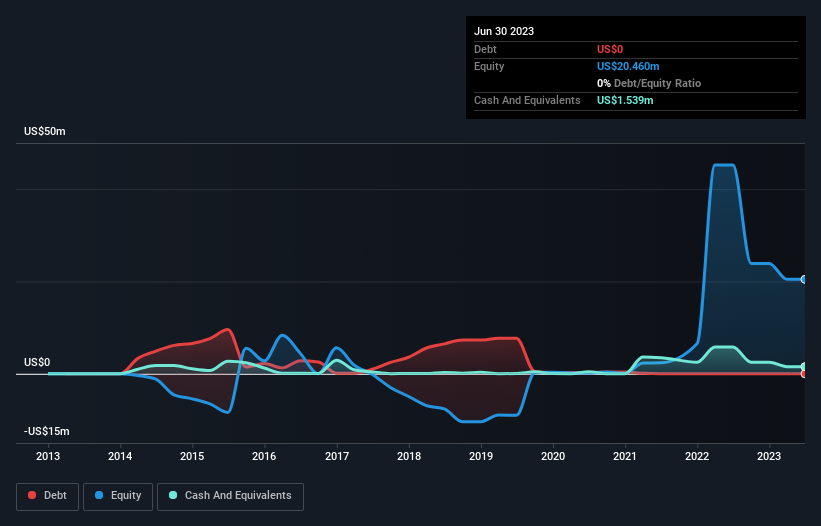We Think Moxian (BVI) (NASDAQ:MOXC) Needs To Drive Business Growth Carefully
Even when a business is losing money, it's possible for shareholders to make money if they buy a good business at the right price. For example, although Amazon.com made losses for many years after listing, if you had bought and held the shares since 1999, you would have made a fortune. But the harsh reality is that very many loss making companies burn through all their cash and go bankrupt.
So, the natural question for Moxian (BVI) (NASDAQ:MOXC) shareholders is whether they should be concerned by its rate of cash burn. For the purposes of this article, cash burn is the annual rate at which an unprofitable company spends cash to fund its growth; its negative free cash flow. First, we'll determine its cash runway by comparing its cash burn with its cash reserves.
Check out our latest analysis for Moxian (BVI)
Does Moxian (BVI) Have A Long Cash Runway?
A company's cash runway is the amount of time it would take to burn through its cash reserves at its current cash burn rate. As at June 2023, Moxian (BVI) had cash of US$1.5m and no debt. Importantly, its cash burn was US$2.6m over the trailing twelve months. Therefore, from June 2023 it had roughly 7 months of cash runway. That's quite a short cash runway, indicating the company must either reduce its annual cash burn or replenish its cash. Depicted below, you can see how its cash holdings have changed over time.
How Is Moxian (BVI)'s Cash Burn Changing Over Time?
In our view, Moxian (BVI) doesn't yet produce significant amounts of operating revenue, since it reported just US$131k in the last twelve months. Therefore, for the purposes of this analysis we'll focus on how the cash burn is tracking. The good news, from a balance sheet perspective, is that it actually reduced its cash burn by 92% in the last twelve months. That might not be promising when it comes to business development, but it's good for the companies cash preservation. Admittedly, we're a bit cautious of Moxian (BVI) due to its lack of significant operating revenues. So we'd generally prefer stocks from this list of stocks that have analysts forecasting growth.
How Hard Would It Be For Moxian (BVI) To Raise More Cash For Growth?
There's no doubt Moxian (BVI)'s rapidly reducing cash burn brings comfort, but even if it's only hypothetical, it's always worth asking how easily it could raise more money to fund further growth. Generally speaking, a listed business can raise new cash through issuing shares or taking on debt. Commonly, a business will sell new shares in itself to raise cash and drive growth. By looking at a company's cash burn relative to its market capitalisation, we gain insight on how much shareholders would be diluted if the company needed to raise enough cash to cover another year's cash burn.
Moxian (BVI) has a market capitalisation of US$31m and burnt through US$2.6m last year, which is 8.6% of the company's market value. That's a low proportion, so we figure the company would be able to raise more cash to fund growth, with a little dilution, or even to simply borrow some money.
How Risky Is Moxian (BVI)'s Cash Burn Situation?
On this analysis of Moxian (BVI)'s cash burn, we think its cash burn reduction was reassuring, while its cash runway has us a bit worried. We don't think its cash burn is particularly problematic, but after considering the range of factors in this article, we do think shareholders should be monitoring how it changes over time. Taking a deeper dive, we've spotted 5 warning signs for Moxian (BVI) you should be aware of, and 2 of them don't sit too well with us.
Of course, you might find a fantastic investment by looking elsewhere. So take a peek at this free list of companies insiders are buying, and this list of stocks growth stocks (according to analyst forecasts)
Have feedback on this article? Concerned about the content? Get in touch with us directly. Alternatively, email editorial-team (at) simplywallst.com.
This article by Simply Wall St is general in nature. We provide commentary based on historical data and analyst forecasts only using an unbiased methodology and our articles are not intended to be financial advice. It does not constitute a recommendation to buy or sell any stock, and does not take account of your objectives, or your financial situation. We aim to bring you long-term focused analysis driven by fundamental data. Note that our analysis may not factor in the latest price-sensitive company announcements or qualitative material. Simply Wall St has no position in any stocks mentioned.

